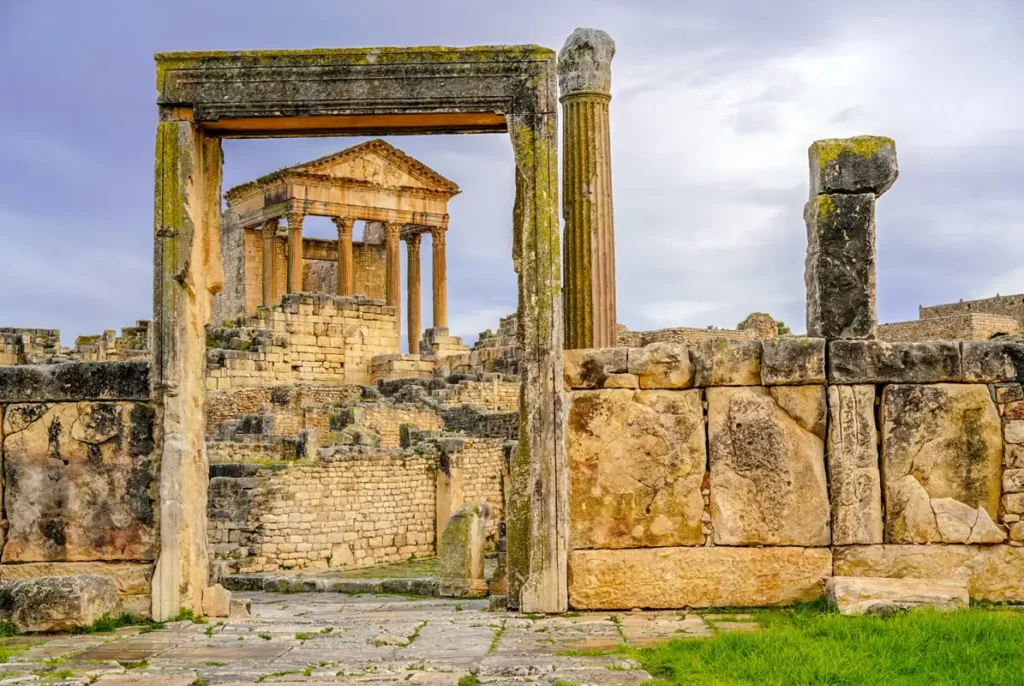Dougga, Tunisia
🏛️ Dougga, Tunisia: The Best-Preserved Roman City in North Africa
Hidden in the rolling green hills of northern Tunisia lies one of the greatest archaeological treasures of Africa — Dougga. Known in antiquity as Thugga, this hilltop Roman city is an open-air museum of temples, baths, theaters, and mosaics spread across a vast, untouched landscape. Often called the “Pompeii of Africa,” Dougga offers visitors a breathtaking experience of Roman urban life — minus the crowds, fences, and tourist traps.
Recognized as a UNESCO World Heritage Site in 1997, Dougga’s remarkable preservation and dramatic setting make it a top-tier destination for lovers of history, archaeology, photography, and immersive travel.
🏛️ A City Through Time: Layers of Civilizations
Dougga predates Roman occupation by centuries. It was originally a Numidian settlement, later absorbed by the Punic world and then transformed by the Romans into a thriving colonial town. Each era left its mark, creating a rare mosaic of cultural layers across 70 hectares of ruins.
Under Roman rule, Dougga became a prominent city in Africa Proconsularis, complete with all the grandeur you'd expect from a provincial capital — temples, forums, a theater, luxurious homes, and advanced water systems.
Today, you can stroll its cobbled streets and trace the lives of people who lived over 2,000 years ago — from priests and senators to farmers and artisans.
🎭 Top Sites You Must Explore
🏛️ Capitolium (Temple of Jupiter)
The architectural crown of Dougga, this 2nd-century CE temple dedicated to Jupiter, Juno, and Minerva dominates the city skyline. With its imposing Corinthian columns and raised platform, it's an iconic symbol of Roman religious power in Africa. The structure remains incredibly intact, and climbing its steps provides sweeping views of the ruins below.
🎭 The Roman Theater
Carved into the hillside in 168 CE, Dougga’s 3,500-seat theater is a marvel of acoustics and design. It’s still used today for performances during the Dougga Classical Music Festival, where the voices of opera and oud blend with the sound of wind rustling through ancient stones.
🏘️ House of Trifolium & Mosaic Residences
Wander through the House of Trifolium, House of Venus, and other domus-style villas, where intricate mosaic floors, courtyards, and frescoes reflect the opulence of Roman domestic life. The mosaics, many of which remain in their original place, are especially stunning in the early morning or late afternoon light.
🕍 Libyco-Punic Mausoleum
One of the oldest monuments in Dougga, this 3rd-century BCE Numidian tower tomb survived centuries and is a rare example of pre-Roman architecture in North Africa. It adds depth to Dougga’s narrative — showing that its grandeur was not born with the Romans, but only reshaped by them.
🚿 Baths and Forums
Don’t miss the Licinian Baths, complete with hypocaust systems, or the Forum, which anchors the public space with columns, inscriptions, and an altar dedicated to the emperor.
🌿 Nature Meets History: A Rural Archaeological Haven
One of Dougga’s most enchanting qualities is its setting. Unlike many historic ruins hemmed in by cities, Dougga sits among olive groves, wheat fields, and rolling hills. The quiet countryside provides a serene atmosphere where you can hear birdsong and the wind instead of traffic or tour guides with megaphones.
This natural integration makes Dougga more than a visit — it’s a journey back in time, with few modern interruptions.
🚗 How to Get There & Around
Dougga is located about 110 kilometers southwest of Tunis, near the town of Téboursouk. There are no direct trains or buses to the site, so the best ways to get there are:
-
By Car: Renting a car from Tunis gives you full flexibility and is the most common approach.
-
Private Tours: Many Tunis-based agencies offer day trips with guides and transport.
-
Taxi from Téboursouk: For budget travelers, reach Téboursouk by bus, then hire a local taxi to Dougga (around 5–10 TND).
Once at Dougga, the site is sprawling but walkable, so wear good shoes, bring water, and be prepared for sun exposure.
📝 Practical Information
-
Opening Hours: Daily from 9 AM to 5 PM
-
Entry Fee: Around 8–10 TND per person
-
Facilities: There are basic toilets and a small visitor kiosk, but few amenities — pack snacks and drinks.
-
Guide Services: Local guides are available on-site or can be pre-booked in Tunis. A guide is highly recommended to unlock the site’s deeper stories.
📷 Best Time for Photos & Visit
-
Golden Hours: Early morning and late afternoon provide warm light and long shadows — ideal for photography.
-
Spring (March–May): Lush green surroundings and wildflowers make the ruins even more magical.
-
Autumn (September–November): Offers cooler weather and fewer visitors.
Avoid the peak summer midday heat, which can be intense and exhausting with limited shade on-site.
🧳 What to Bring
-
Sunhat, sunscreen, and sunglasses
-
Comfortable walking shoes (there’s uneven terrain)
-
Water and light snacks
-
Camera or smartphone with extra storage — you’ll want lots of photos
-
A notebook, if you love sketching or journaling while exploring
🌟 Why Dougga Should Be on Your Travel List
Dougga is more than a historical site — it's a time capsule of North African antiquity. Unlike ruins boxed in behind fences or glass, Dougga welcomes you to walk, touch, and connect with the past. There’s something deeply moving about standing alone in a 2,000-year-old theater, hearing only the wind, and imagining applause echoing off stone walls.


